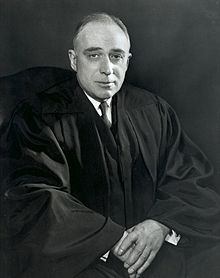
Back جون مارشال هارلان الثاني Arabic جون مارشال هارلان التانى ARZ جان مارشال هارلان (سیاستچی) AZB John Marshall Harlan II German John Marshall Harlan II French ג'ון מרשל הרלן השני HE John Marshall Harlan II ID Харлан, Джон Маршалл II Russian John Marshall Harlan II SIMPLE Џон Маршал Харлан II Serbian
John Marshall Harlan II | |
|---|---|
 | |
| Associate Justice of the Supreme Court of the United States | |
| In office March 28, 1955 – September 23, 1971 | |
| Nominated by | Dwight D. Eisenhower |
| Preceded by | Robert H. Jackson |
| Succeeded by | William Rehnquist |
| Judge of the United States Court of Appeals for the Second Circuit | |
| In office February 10, 1954 – March 27, 1955 | |
| Nominated by | Dwight D. Eisenhower |
| Preceded by | Augustus Noble Hand |
| Succeeded by | J. Edward Lumbard |
| Personal details | |
| Born | John Marshall Harlan May 20, 1899 Chicago, Illinois, U.S. |
| Died | December 29, 1971 (aged 72) Washington, D.C., U.S. |
| Resting place | Emmanuel Church Cemetery, Weston, Connecticut, U.S. |
| Spouse |
Ethel Andrews (m. 1928) |
| Children | 1 |
| Parent |
|
| Relatives | John Marshall Harlan (grandfather) |
| Education | Princeton University (AB) Balliol College, Oxford New York Law School (LLB) |
| Military service | |
| Allegiance | United States |
| Branch/service | |
| Years of service | 1943–1945 |
| Rank | Colonel |
| This article is part of a series on |
| Conservatism in the United States |
|---|
 |
John Marshall Harlan (May 20, 1899 – December 29, 1971) was an American lawyer and jurist who served as an associate justice of the U.S. Supreme Court from 1955 to 1971. Harlan is usually called John Marshall Harlan II to distinguish him from his grandfather, John Marshall Harlan, who served on the U.S. Supreme Court from 1877 to 1911.
Harlan was a student at Upper Canada College and Appleby College and then at Princeton University. Awarded a Rhodes Scholarship, he studied law at Balliol College, Oxford.[1] Upon his return to the U.S. in 1923 Harlan worked in the law firm of Root, Clark, Buckner & Howland while studying at New York Law School. Later he served as Assistant U.S. Attorney for the Southern District of New York and as Special Assistant Attorney General of New York. In 1954 Harlan was appointed to the United States Court of Appeals for the Second Circuit, and a year later president Dwight Eisenhower nominated Harlan to the United States Supreme Court following the death of Justice Robert H. Jackson.[2]
Harlan is often characterized as a member of the conservative wing of the Warren Court. He advocated a limited role for the judiciary, remarking that the Supreme Court should not be considered "a general haven for reform movements".[3] In general, Harlan adhered more closely to precedent, and was more reluctant to overturn legislation than many of his colleagues on the Court. He strongly disagreed with the doctrine of incorporation, which held that the provisions of the federal Bill of Rights applied to the state governments, not merely the Federal.[4] At the same time, he advocated a broad interpretation of the Fourteenth Amendment's Due Process Clause, arguing that it protected a wide range of rights not expressly mentioned in the United States Constitution.[4] Justice Harlan was gravely ill when he retired from the Supreme Court on September 23, 1971.[5] He died from spinal cancer three months later, on December 29, 1971. After Harlan's retirement, President Nixon appointed William Rehnquist to replace him.
- ^ Cite error: The named reference
Yarbroughwas invoked but never defined (see the help page). - ^ Cite error: The named reference
paperswas invoked but never defined (see the help page). - ^ Cite error: The named reference
Yarbrough1989was invoked but never defined (see the help page). - ^ a b Cite error: The named reference
Vasickowas invoked but never defined (see the help page). - ^ Cite error: The named reference
Dorsen139was invoked but never defined (see the help page).
© MMXXIII Rich X Search. We shall prevail. All rights reserved. Rich X Search